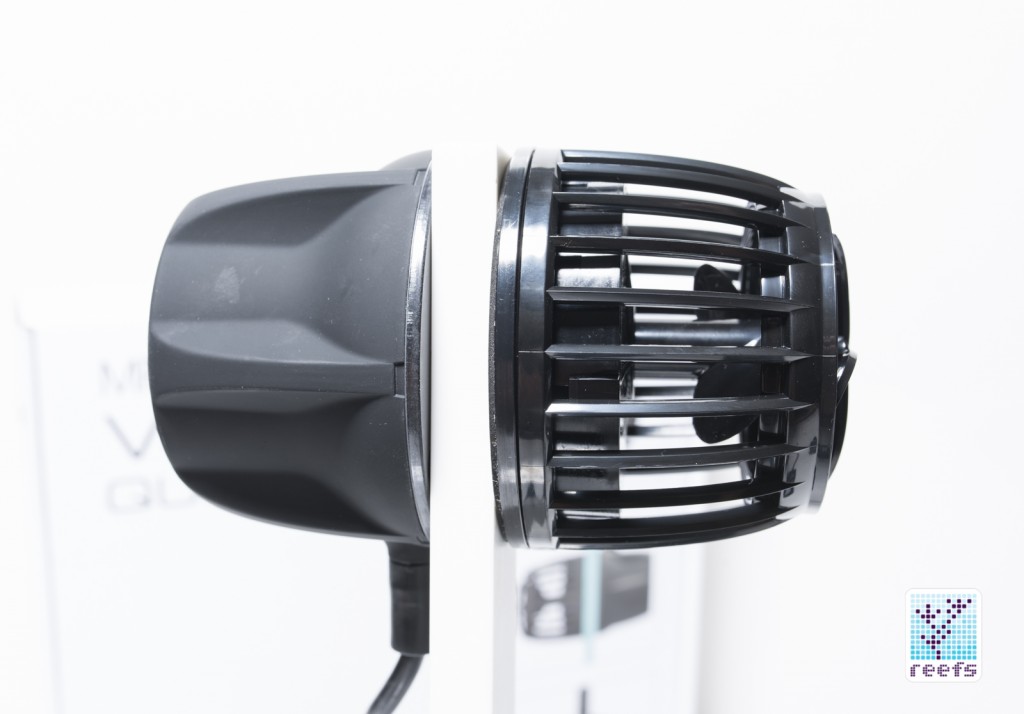
Once every decade or so, a product comes out that redefines and revolutionizes the industry it belongs to. Just like a smartphone for mobile communications, an electric car that goes 0-60 in under 3 seconds for automotive technology, or a remote-controlled drone for aerial surveillance and photography, EcoTech’s introduction of the VorTech Propeller Pump in 2005, revolutionized the home aquarium water-movement products industry. This innovative product transformed Ecotech from a student-run start-up project to one of the best known names in the aquarium industry. Ten years later, the “wave-maker” has been remade for the third time, complete with new features and a completely re-engineered controller. What’s so special about the new driver? Let’s find out…
INTRODUCTION
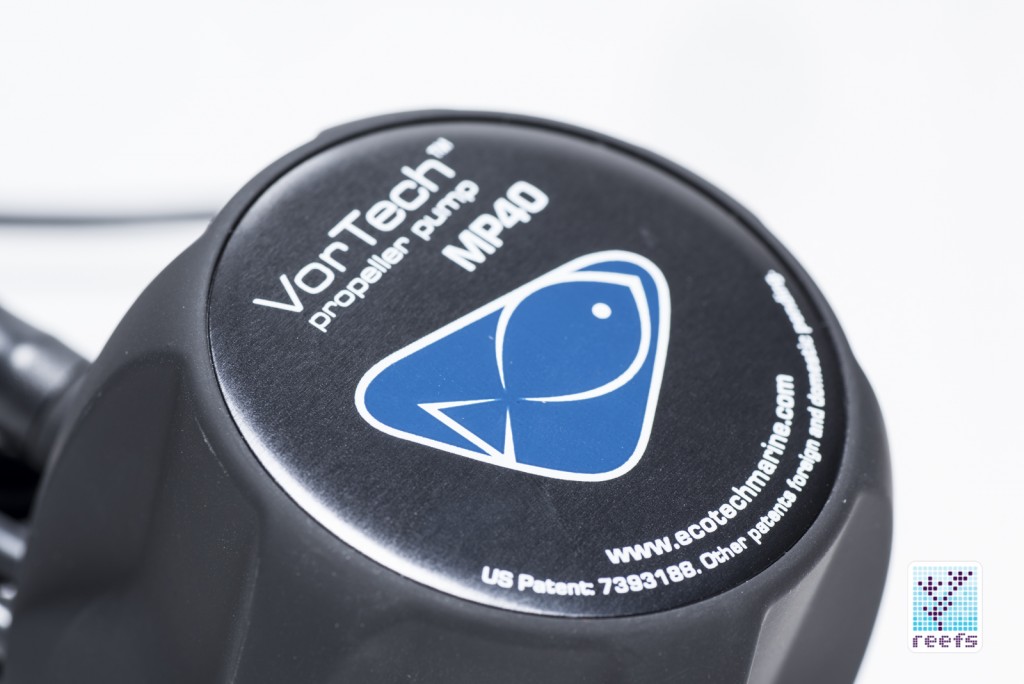
The story behind Ecotech Marine and its founders is quite interesting: the company was founded by two undergraduate students – Tim Marks and Justin Lawyer, who met in a reef forum chat room and immediately found common ground in their shared vision of products that would help maintaining a reef aquarium. They designed and built their first piece of equipment, a Kalkwasser Reactor, in Marks’ basement, using nothing but personal savings to fund the project. The prototype was well received among hobbyists, and they soon joined forces with reef enthusiast Patrick Clausen, with whom they planned to manufacture more units and sell them online. The new team, looking for additional funds for their project, entered an “Invitation to Innovate” contest at Clausen’s home college, Lehigh University. They won, and then received an additional grant from NCIIA to continue developing and improving their reactor.
EcoTech sold all the reactors they’d manufactured and wanted to grow the company; they hoped to introduce a brand new product to the market, something fresh that hadn’t been done before…
The turning point came when Tim Marks met Andy Howard, CEO of Icecap, a well-known company in the reef hobby industry. Marks showed him plans for a new type of circulation pump he called vortech, and Howard immediately approved of the idea. The two men signed a partnership agreement and Ecotech went back to the garage to build a prototype of this new pump. With financial help from Icecap and few additional academic grants, Ecotech built the prototype, filed for a patent and, in 2005, the vortech propeller pump hit the market. It was an instant success, a product so innovative that Ecotech became a well- known name amongst aquarists just months after vortech started showing up on shelves.
Today, Ecotech Marine itself is considered one of the major “players” in the aquarium industry, with a line of products raging from coral glue to LED lights, to pumps designed with the modern reefkeeper in mind.
WHAT IS vortech?
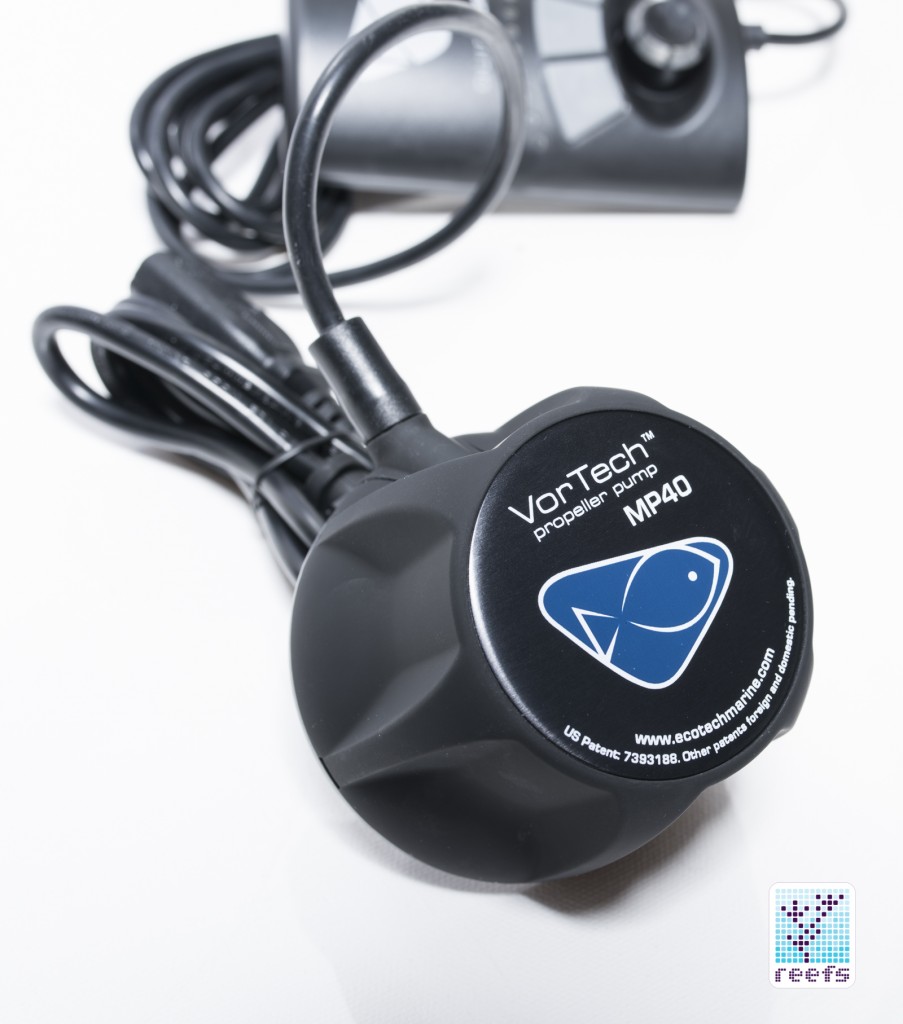
Ecotech vortech is a propeller pump that simulates wave action, present on a coral reef, in the home aquarium. The pump consists of two, magnetically coupled sides, universally called the “wet” side and the “dry” side. The “dry” side, containing the motor, is kept outside the tank, which prevents heat from being transferred to the aquarium water. The “wet” side, consisting of an impeller protected by a plastic cover, is what creates the flow. Both sides, when aligned together through the tank’s glass, complete the pump; when on, motor on the dry side transfers kinetic energy on to the wet side, and the whole device works just like any other propeller pump. This ingenious idea helps minimize the equipment inside the tank, reduces the amount of heat that is transferred from the running motor, and completely eliminates the risk of electric shock.
The other thing that makes vortech unique is the driver that comes with the pump. It controls both speed and flow pattern, and can synchronize multiple pumps wirelessly.
WHAT’S NEW?
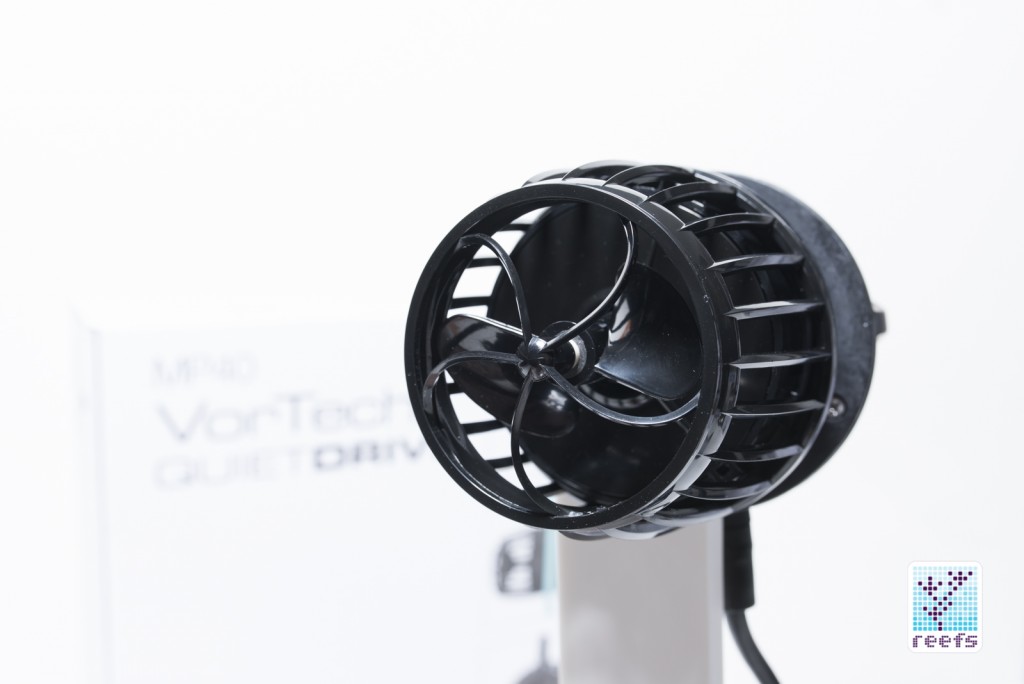 Vortech comes in three sized models: MP10 is the smallest of the three, then MP40- the model I’m reviewing, and finally the “flow monster” MP60, designed for the largest of home aquariums.
Vortech comes in three sized models: MP10 is the smallest of the three, then MP40- the model I’m reviewing, and finally the “flow monster” MP60, designed for the largest of home aquariums.
The MP10 Quiet Drive (QD) and the MP60 QD have a new, improved driver that offers a rather dramatic impeller/motor noise reduction (90% more quiet than the previous generation, according to Ecotech), 6 main flow modes (with a new “Gyre” mode that replaces “Long Pulse” on the previous driver) and a new black color; the pump assembly for both models is identical to the previous generation.
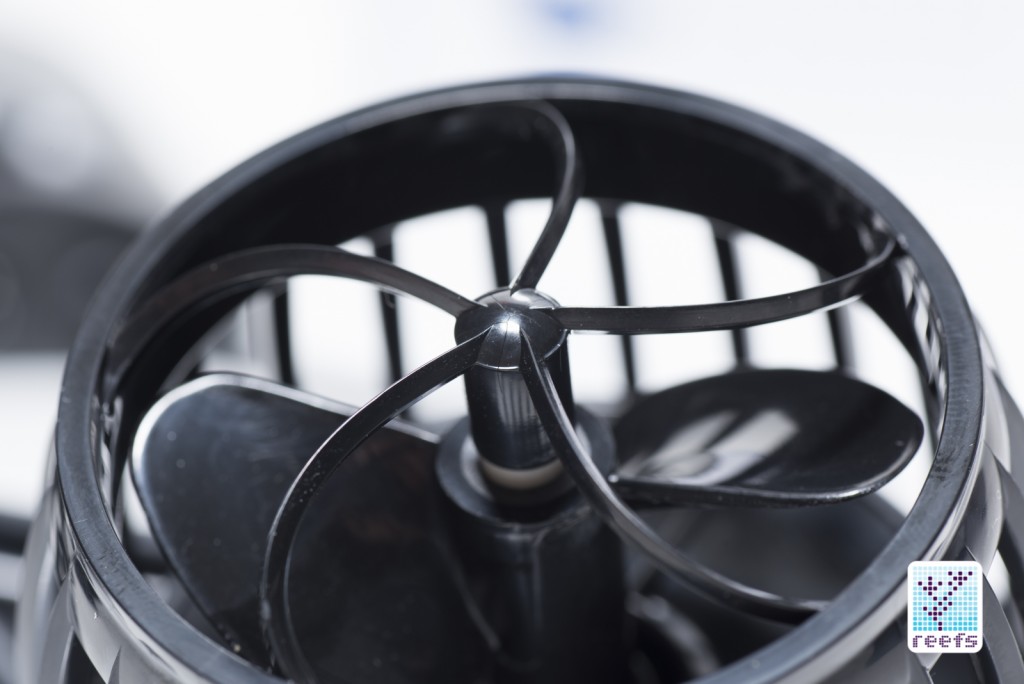
The MP40 QD model has the most improvements. In addition to the improved driver, the mechanics of the motor assembly (“dry side”), the impeller housing (“wet side”), and the power supply were redesigned and improved, making it essentially an entirely new product. The result: same 90% noise reduction as with the other two models and, in addition, a 40% increase in water volume the pump is able to push, from 3200 GPH (gallon per hour- 12,100 lph) on the previous MP40 ES model, to 4500 GPH (17,000 lph) on the MP40 QD.
You may ask, “How did they manage to reduce noise by a whooping 90% by improving the driver, when it’s the motor that makes all the noise?”. It all comes down to improvements to the “communication” between the driver and the propeller: Ecotech rewrote the program (and probably swapped some electronic components as well) that operates the direct current motor torque, resulting in a smoother transition when the pump’s impeller changes speed and effectively reduces the noise that gets generated in the process.
The new driver holds the majority of the upgrades for the QD line; existing vortech pump owners can purchase it alone to enjoy (almost) all the benefits. Upgrading the MP40 driver will result in noise reduction, but if you desire the additional 1300 GPH of flow, you have to buy the new pump as a whole rather than upgrading its parts (it’s the new “wet” and “dry” sides that generate the additional flow).
Finalizing this lengthy introduction, the new line of QuietDrive pumps is, like previous vortech updates, fully upgradeable for existing users. The QD driver is compatible with all previous models, be it WWD or ES, and can communicate with them for synchronized flow patterns without any modifications needed. Let’s look at the actual product and see what Ecotech brought us this time…
UNBOXING
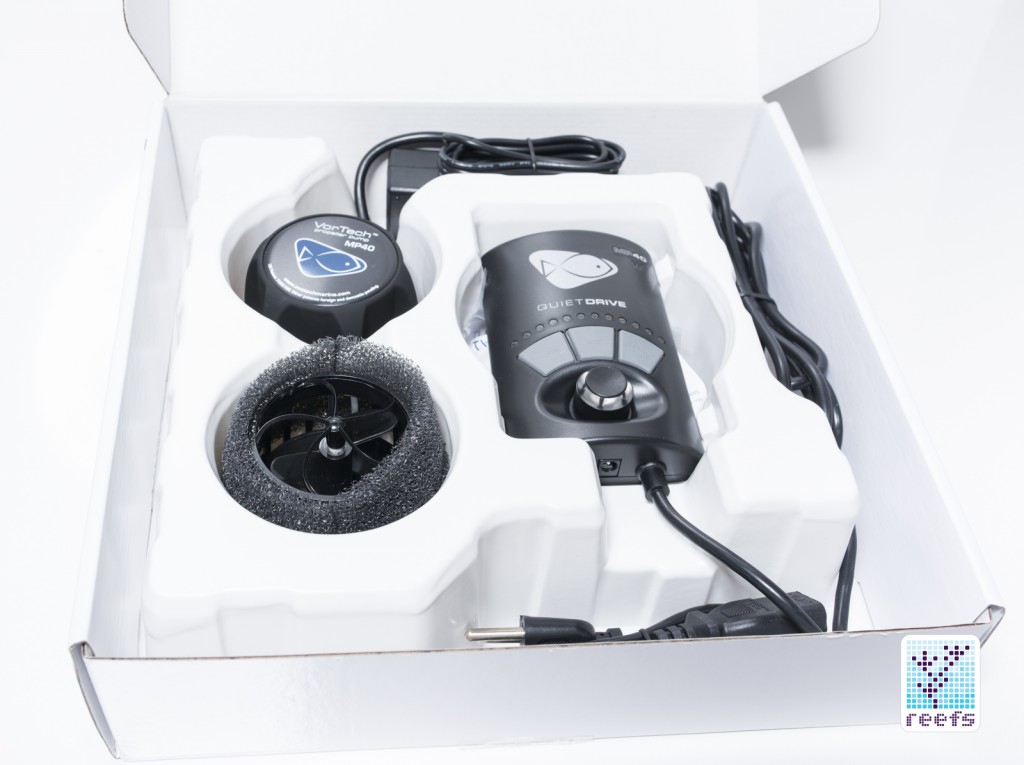
Ecotech is known for its quality and attention to details, especially when it comes to packaging their products and vortech MP40 QD follows suit: within the elegant white cardboard box, secured in a plastic mold are the contents of MP40 QD package:
- AC/DC power supply
- Pump impeller (“wet” side)
- Motor assembly (“dry” side)
- vortech wireless driver
- Three spacers for different glass thickness
- Color booklet/ manual
- Mounting hardware (zip-ties, double sided tape to mount the driver, zip-tie holders)
- Foam sleeve for the wet side to protect smaller fish from being sucked in by the impeller
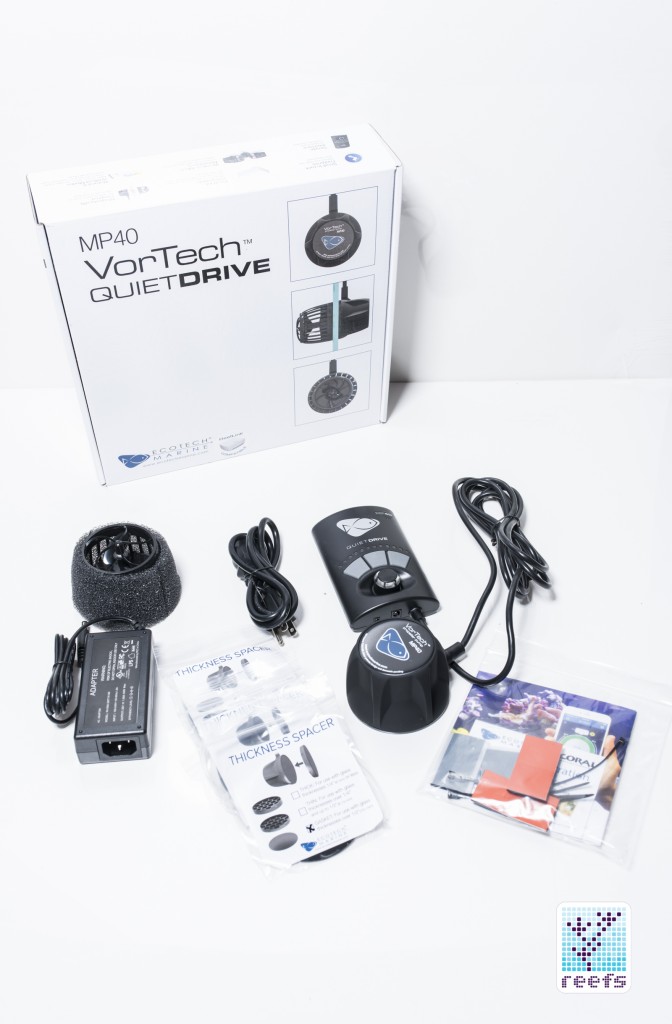
Each of the two main components (driver and pump assembly) deserve a closer look and some explanation; let’s start with the mechanical side of vortech.
THE PUMP
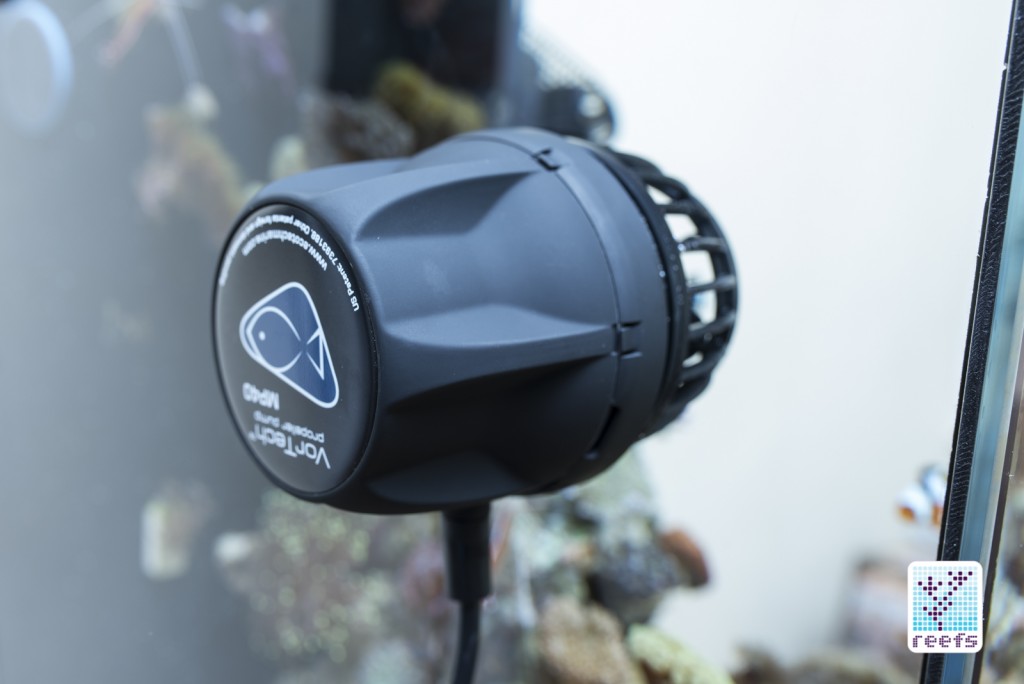
Pictured above is the “dry side”, it hides the motor sealed in a hard plastic enclosure and it is hardwired to the driver/controller.
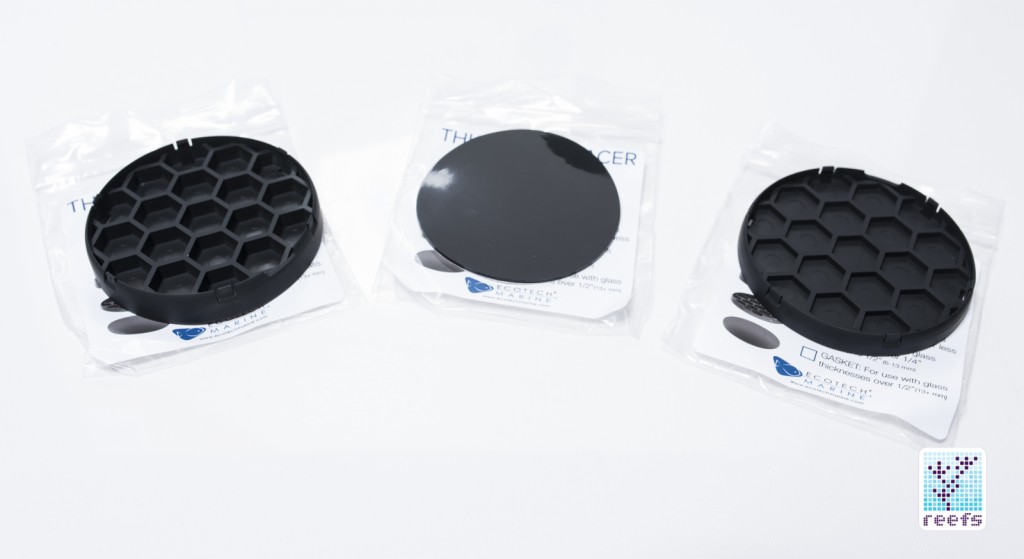
For the MP40 QD to work properly, the user must determine the glass thickness of his/her tank and install a matching spacer. Three sizes come with the pump, one for tanks with glass thickness up to 3/4″, one for glass between 3/8”- ½” and one for tanks with glass ¼” or less thick. The smaller two click into the glass-facing side of the motor assembly with ease and the ¾” spacer, a thin piece of sticky rubber cut in the pump’s shape, blends in with the “dry” side perfectly.
The “wet” side attaches to the “dry” side with magnetic force and needs to be aligned before its first use.
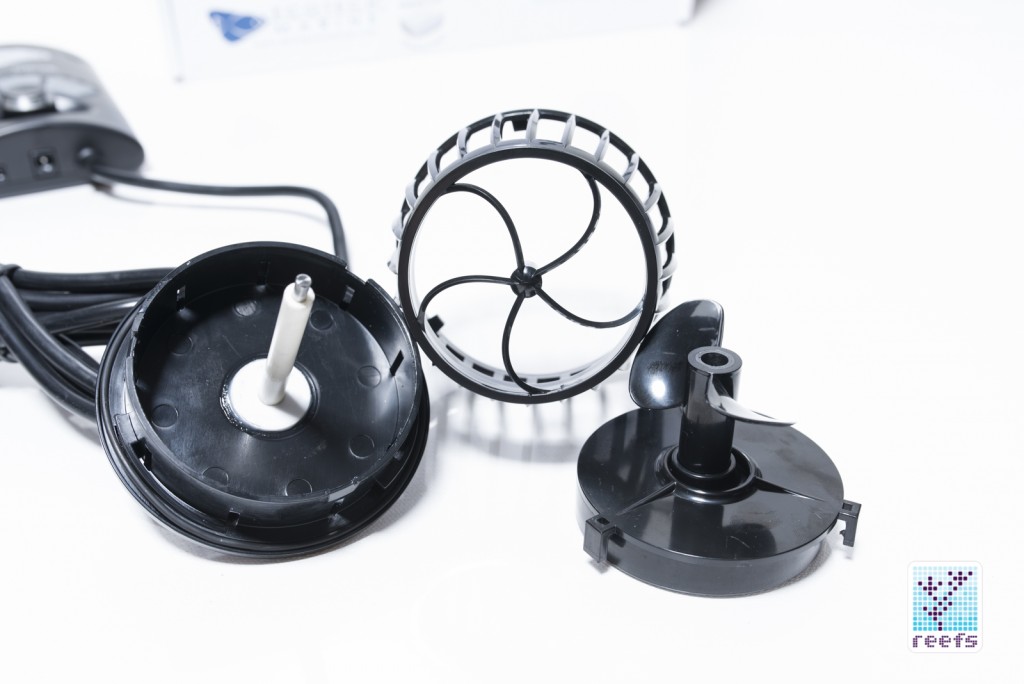
The impeller can be disassembled for cleaning by turning the nozzle counter-clockwise and un-clicking the three hooks that hold the impeller in place. Disassembling the impeller side takes less than 30 seconds and requires no tools. The “dry” side, while not rated as waterproof, is completely sealed and should survive minor spills without issues.
The dimensions are illustrated below.
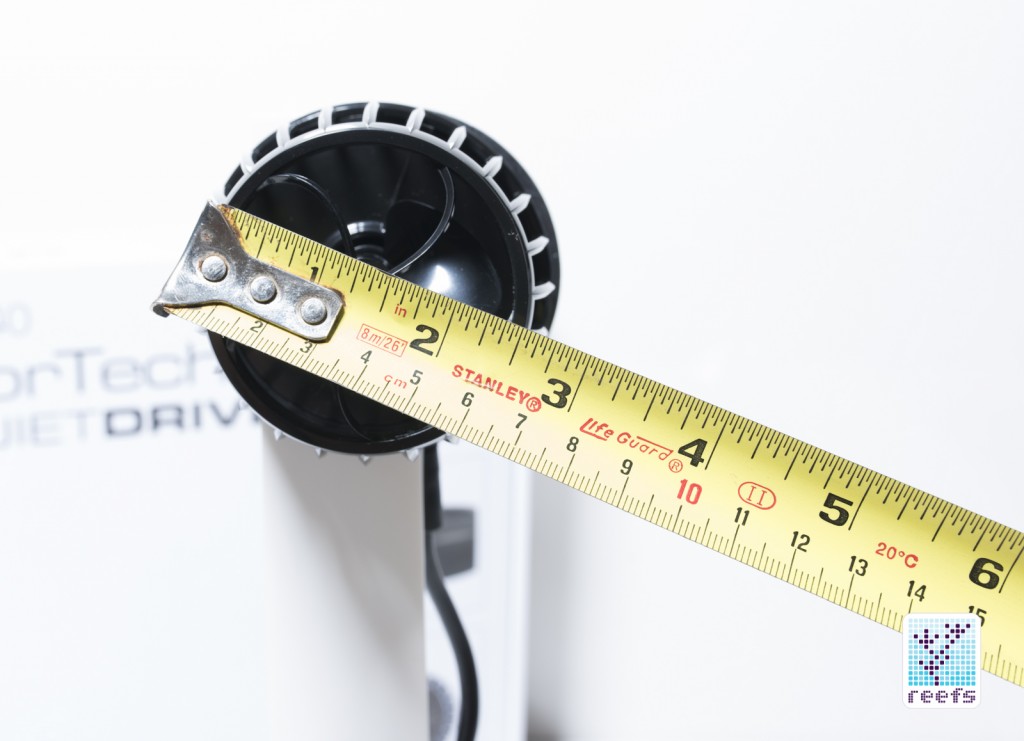
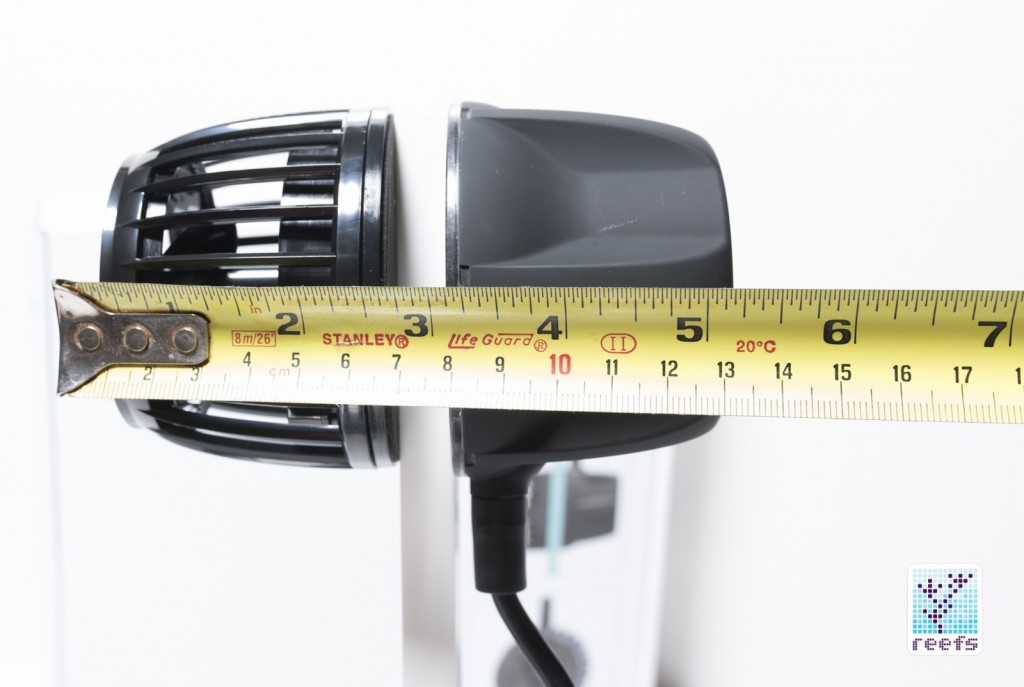
In summary, the pump assembly leaves nothing to be desired, the overall feel is of quality- the impeller and the case it sits in are made of impact-resistant plastic, molded to a smooth, uniform finish.
DRIVER
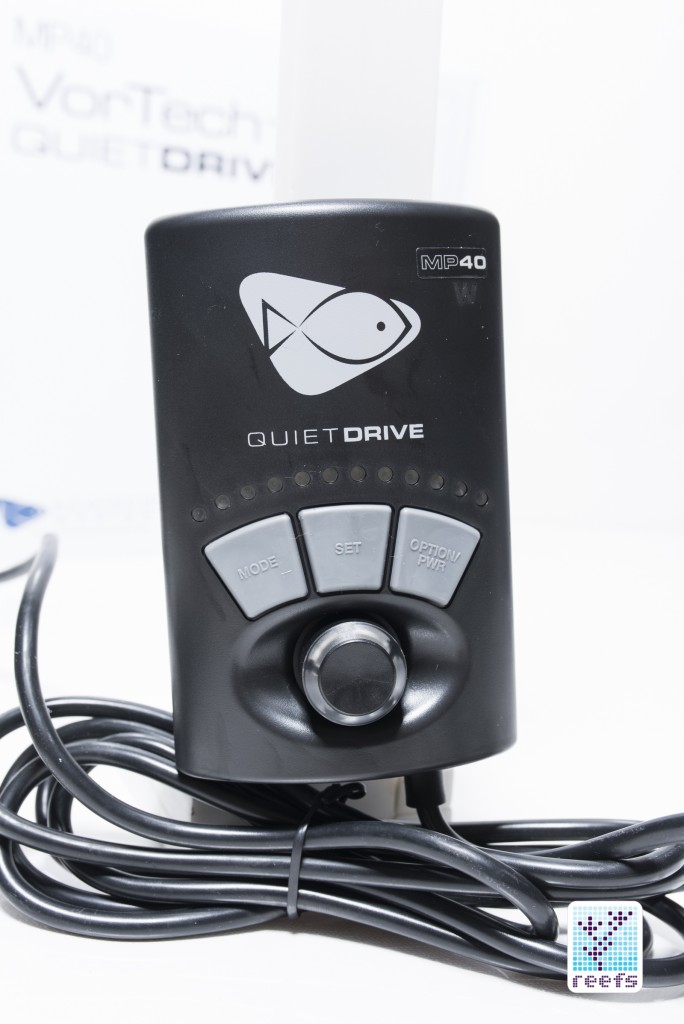
An integrated electronic driver is the heart and soul of all Vortechs; the amount of controllability the driver allows is astounding- not only you can change the speed of the impeller’s rotation, but also implement one of the six pre-programmed flow patterns, enter the feeding mode, wirelessly synchronize more than one vortech pumps, and even remotely control the pump with the Ecotech wireless hub. I will talk about each and every function of the driver later in the review, meanwhile let’s take a closer look at the physical aspects of it.
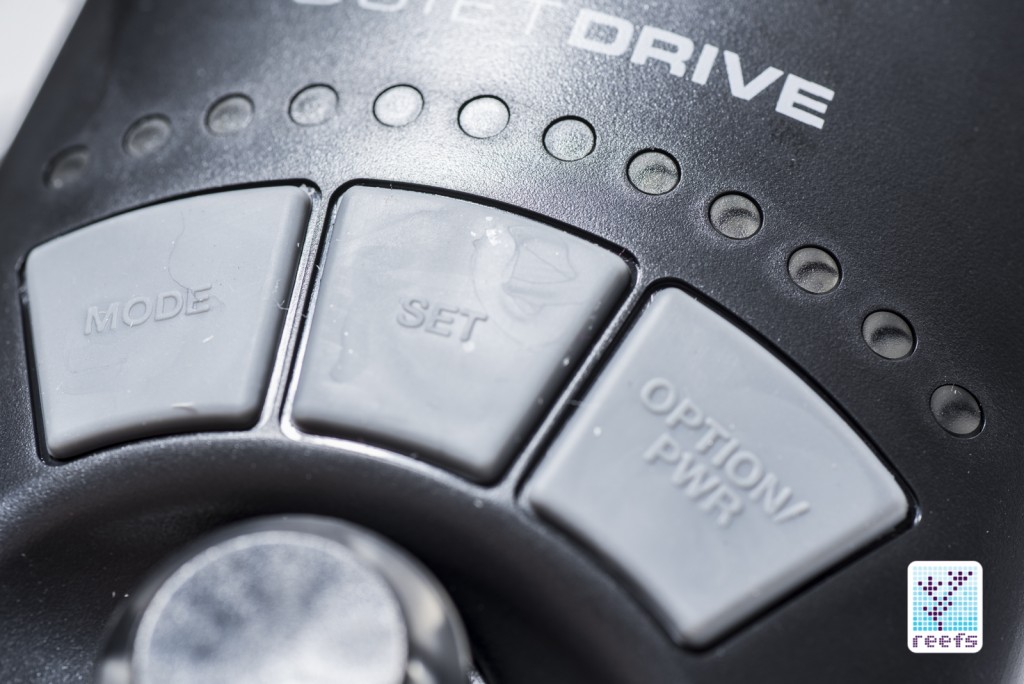
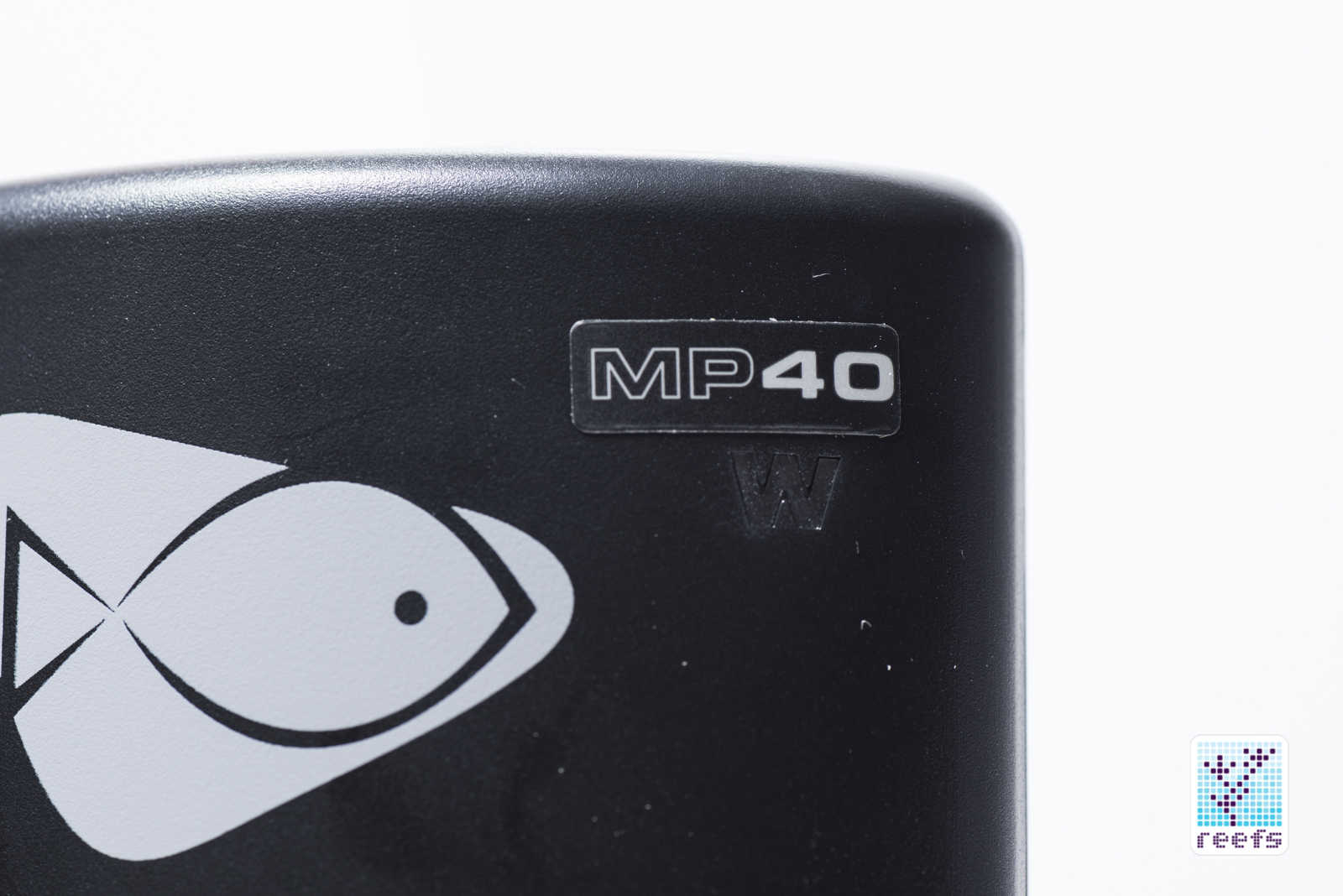
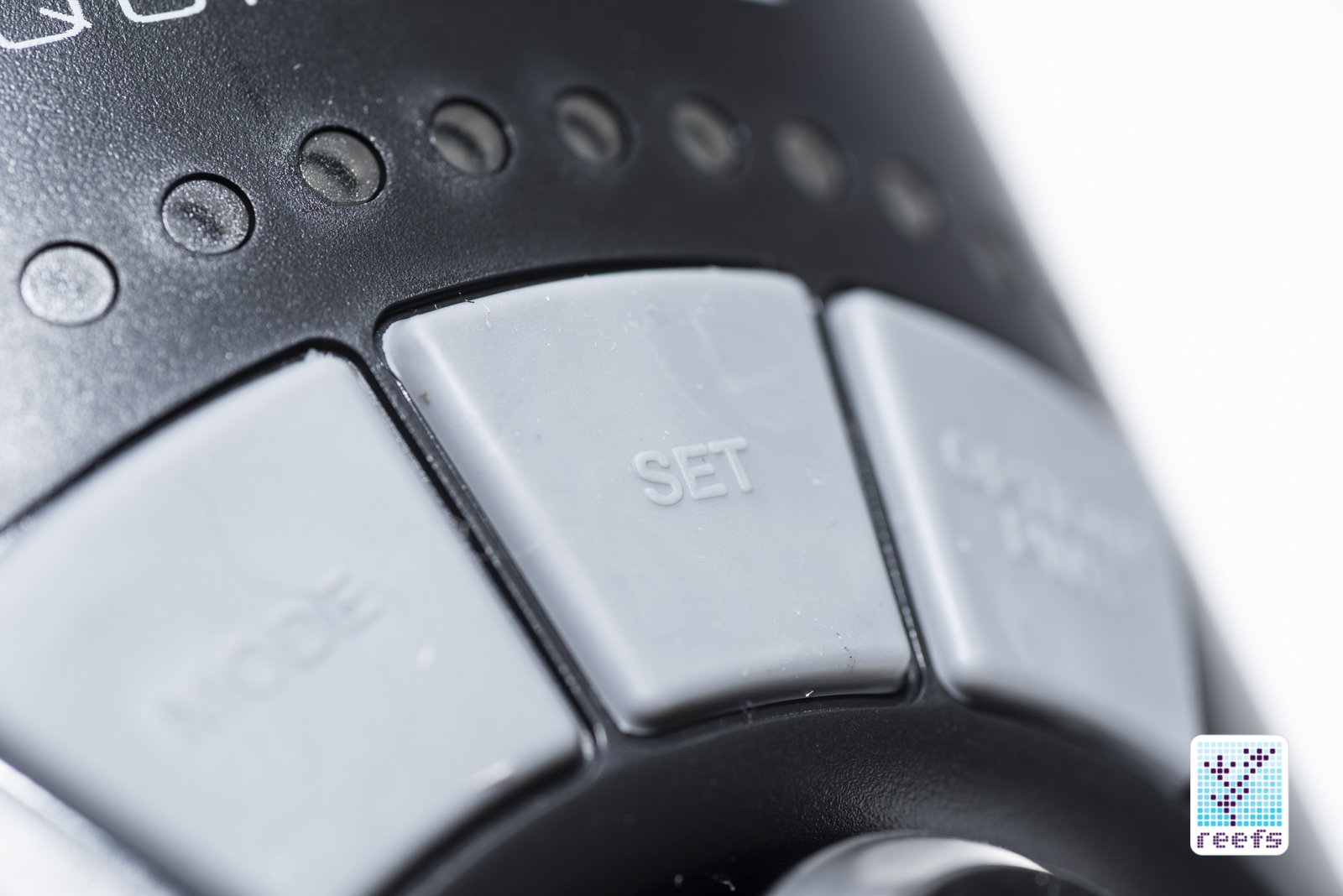
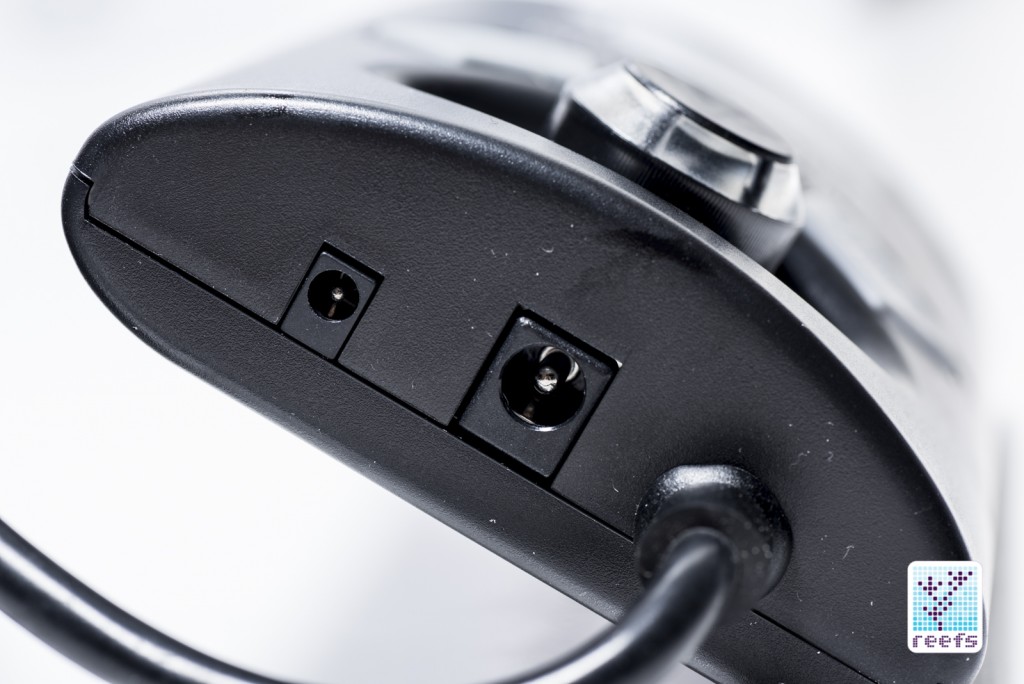
The new vortech driver looks virtually the same as the one shipped with previous generations of Ecotech propeller pumps, except that the company decided to enclose it in matte black case this time around. This design blends functionality with appearance, so you don’t have to hide it from view, tucked in between a spider web of cables inside the stand. On the “face” of the unit is a centrally-located turn knob, a row of indicator LEDs above it and three large, rubber-covered buttons below, all arranged together in an arc shaped layout.
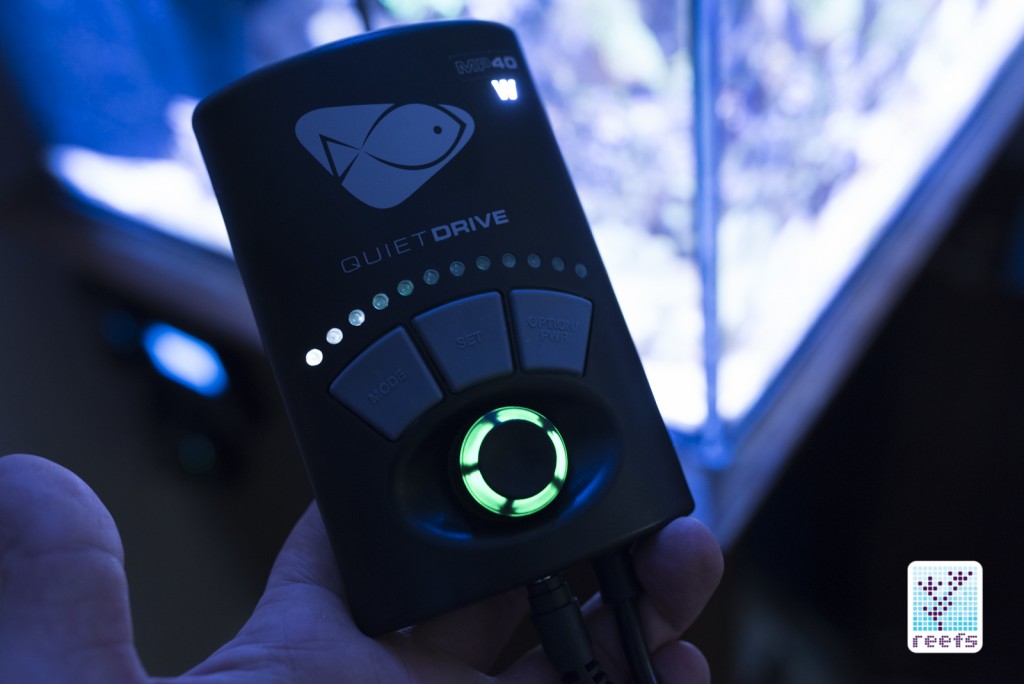
The knob’s multicolor LED emitters light up when the pump is on, and inform the user of the current setting. The physical buttons, labeled from left to right: MODE, SET and OPTION/PWR operate all functions within the driver.
The vortech driver, with its pre-programmed flow modes, has made it possible for aquarists to better mimic conditions on the reef since the original model was introduced in 2005. In its newest iteration, there are six settings to choose from, represented by a changing colors on the speed dial. Pressing the “MODE” button shifts through them:
- Lagoon mode
In this mode, the pump increases and decreases speed gently, simulating conditions at a lagoon part of the reef. Useful in soft coral dominated tanks that don’t require rapid flow change. The speed dial sets maximum flow for this mode
- Reef crest mode
Reef Crest is by far the favorite mode with vortech enthusiasts and it’s easy to see why- it simulates the high energy reef crest section of the reef, where constant crashing waves bring chaotic flow that effectively redistributes nutrients. In this mode, the pump changes speed randomly, but unlike Lagoon mode, there are periods in the flow pattern where vortech speeds up abruptly, simulating an incoming wave. Reef Crest is widely used in SPS tanks that require large amounts of flow. The speed dial sets maximum flow.
- Short pulse mode
A classic “wave maker”, in short pulse mode, as name suggests, the pump give out “pulses” of flow, where the impeller ramps up rapidly and then stops. User can choose the wave’s strength by setting up the time in between pulses as well as maximum speed
- Tidal swell mode
A very interesting program that effectively mimics conditions on the reef in the span of an entire day, with prolonged flow cycles. In this mode, the pump will build up momentum over the course of more than two hours, shifting alternately between periods of high flow and gentle swell. The whole cycle ends with a powerful surge that helps remove detritus accumulated on live rock and starts over again. When more than one vortech pump is communicating wirelessly, the program alternates between cycles, creating an interesting, harmonious flow in the tank. In this mode, speed dial is used to set the maximum flow
- Gyre mode
Gyre mode is somewhat similar to “short pulse” in that it outputs a wave-like flow pattern with periods where impeller comes to a complete stop. The main difference is that in Gyro the time pump builds a wave can be set anytime between 2 seconds and 2 hours, resulting in a less chaotic flow in the tank. Gyre is a new mode exclusive to the QuietDrive driver and it replaces “long pulse” mode found in previous vortech models.
- Nutrient transport mode
Another program that creates an unorthodox flow pattern inside the tank. Aimed mainly for tanks hosting SPS (short polyps stony) corals, in this mode the pump goes through a cycle, in which the first part consist of a wave-like flow (similar to short-pulse) followed by a phase of high energy surge designed to transport detritus out of the tank and into the overflow
In addition, there are two additional settings that change how the pump behaves in certain situations without affecting one of the six main modes:
- Feed mode
Feed mode disrupts the currently used setting temporarily for 3 minutes, slowing down the pump to its minimum speed and allowing for a break to feed tank’s inhabitants. If not canceled manually, vortech comes back to normal operation after feeding mode time elapses.
- Night mode
This mode allows for slowing down the pump(s) at night. Unlike other pumps on the market, vortech does not have a light sensor and instead uses a pre-programmed setting (that can be tweaked) to determine the night mode setting. At default, the pump slows down to 50% of the normal speed for 10 hours
- Battery backup mode
That mode works only with an optional Battery Backup device that Ecotech sells to provide temporary “juice”in case of power disruptions. When battery backup is linked with vortech pump and an user experiences power outage, the pump automatically enters battery backup mode, slowing down to the minimum speed to conserve energy
- Auto tune
Auto tune mode is essentially a variation of Short Pulse mode, with the only difference being that the “wave” can be customized and set based on the observation of one’s aquarium. An user sets the wave “height” and “strength” using a simple procedure, described in details in this Ecotech video
vortech DRIVER WIRELESS
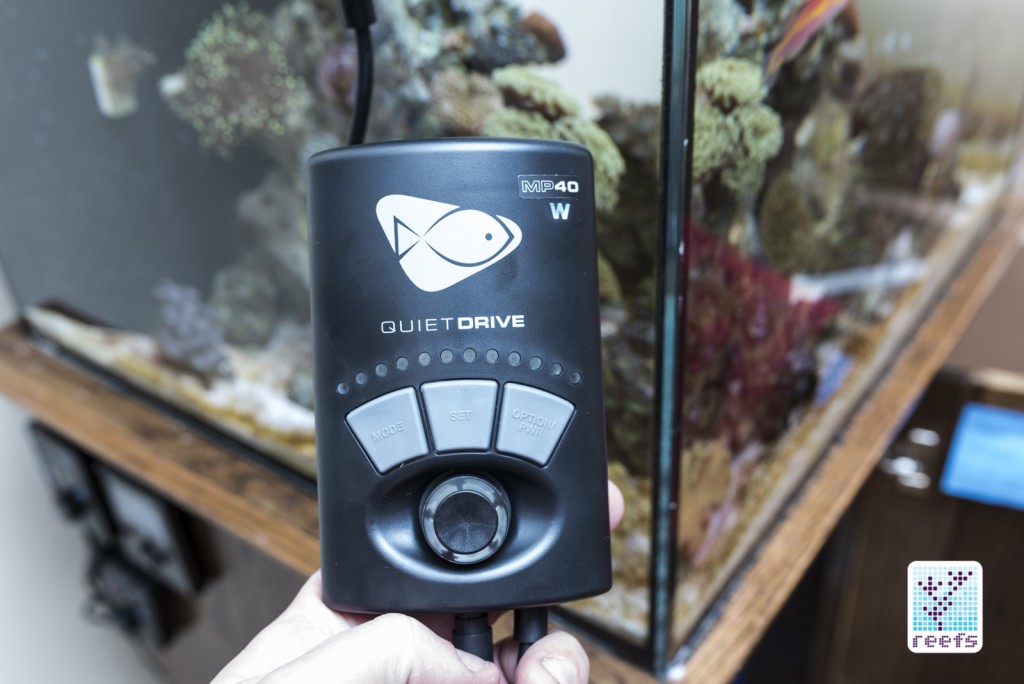
Having more than one vortech pump (any model; every new generation of pumps offer backwards compatibility) opens a window of opportunities, as long as the driver has a built in wireless module (identified by a glowing “W” letter on the driver body). In the current QuietDrive generation, only the MP10 model offers both non-wireless and wireless driver options, while the MP40 and MP60 come with wireless driver as standard. The vortech driver’s wireless capabilities allow for synchronizing multiple pumps to follow the same flow pattern. Each wireless driver has a built in RF transmitter to communicate with others in a master-slave configuration, where one pump is set as a commander that controls all other drivers. For example, in a short pulse mode, you can set up two (or more) pumps to be synchronized, where both impeller start spinning at exact same time, or asynchronized , where pump pairs spin in turns. This synchronization works for each of the 6 main modes and is especially useful when a standing wave or/and an uniform water circulation within the tank is desired.
Another, more sophisticated option offered by vortech wireless driver, arises when the pump is added to Ecotech’s ReefLink, sold separately as an accessory, wireless hub. Combined with EcoSmart Live, a web-based platform and/or a dedicated smartphone app (available for Apple IPhone and Android devices), the wireless platform allows for remote control of vortech pumps and other Ecotech equipment wherever Internet access is available. When activated, each vortech can be accessed via Ecosmart Live, where a user can change all the settings without touching the driver itself.
Finally, all EcoTech propeller pumps are compatible with Neptune Systems apex Aquacontroller via VDM accessory module. Vortech drivers are fully compatible with apex programming language, which allows for plenty of customization of flow modes. For example, using apex Fusion (Neptune Systems web interface), an aquarist can program specific flow modes for different times of day and ultimately create a flow pattern closely resembling changing conditions on the reef.
FIRST TIME SETUP AND PUMP TEST
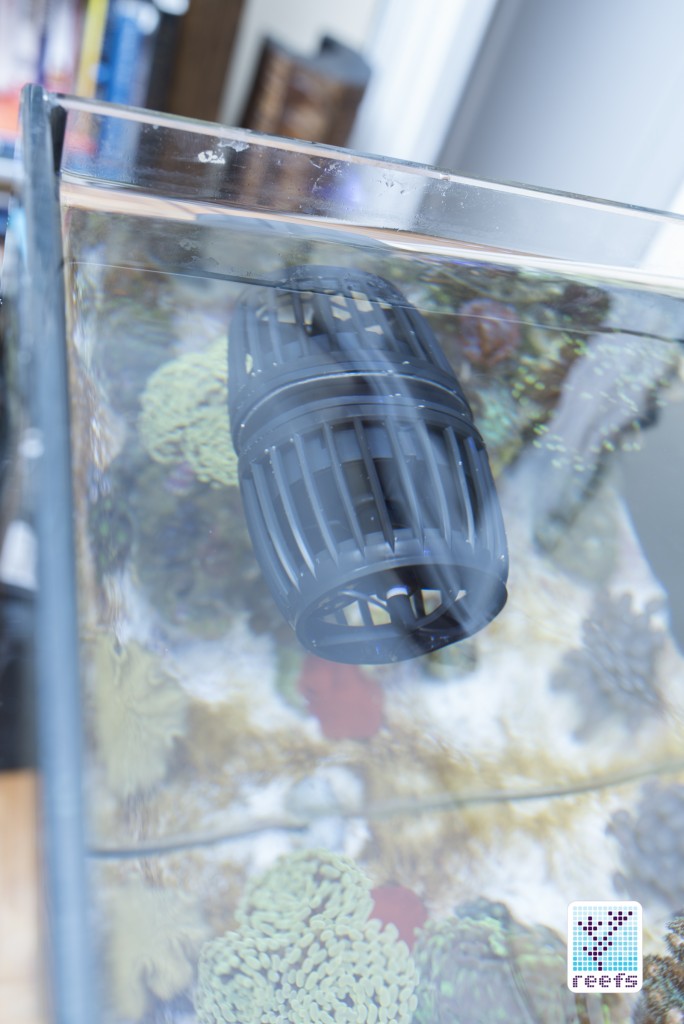
Before I continue with testing processes, I have to say that I am familiar with Ecotech pumps since the first generation of Vortechs. I used to have both MP10s and MP40s pumps in my various tanks and was always pleased with how they worked. The only drawback with the MP40 was the noise level; you could hear the pump from across the room. I was eager to see if Ecotech‘s claims about the noise reduction was true. Anyway, let’s start with initial setup and go through the different modes vortech driver offers.
The installation process is pretty straight-forward and does not require any technical knowledge. Nevertheless, Ecotech offers instruction manuals and installation videos to help customers get through the process (links at the end of the article).
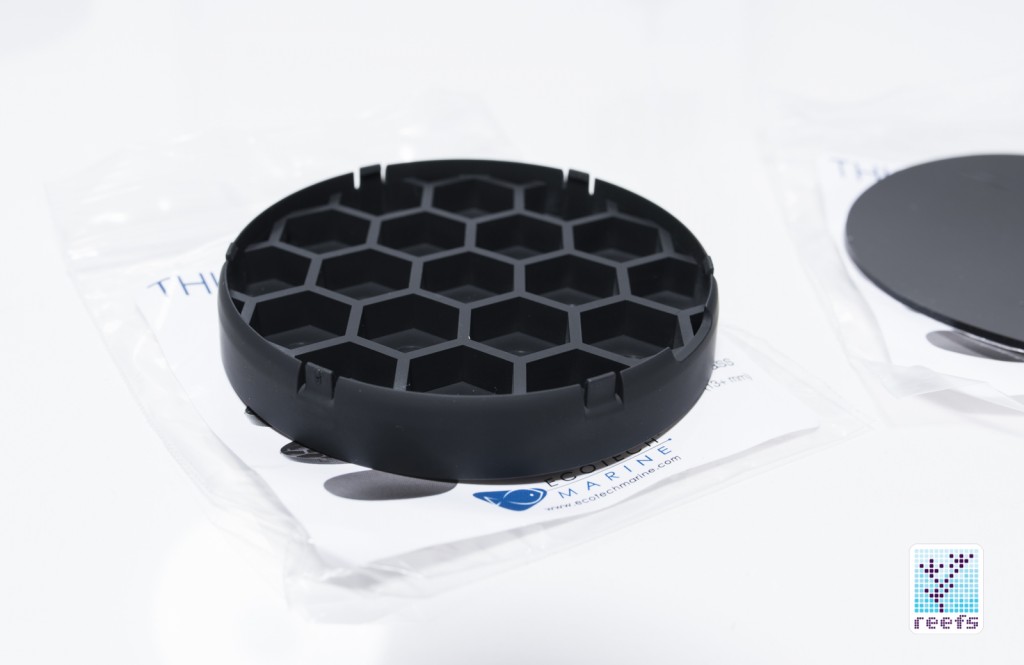
To install, attach the correct spacer to the “wet” side of the pump assembly and align it with the “dry” side. The driver can be then attached to the aquarium stand with the provided double side tape or, alternatively, with an optional bracket Ecotech sells at their online store. vortech is ready to use just a few seconds after plugging in the power supply. It automatically goes to constant speed mode at the lowest setting, letting you switch between modes with a touch of a button.
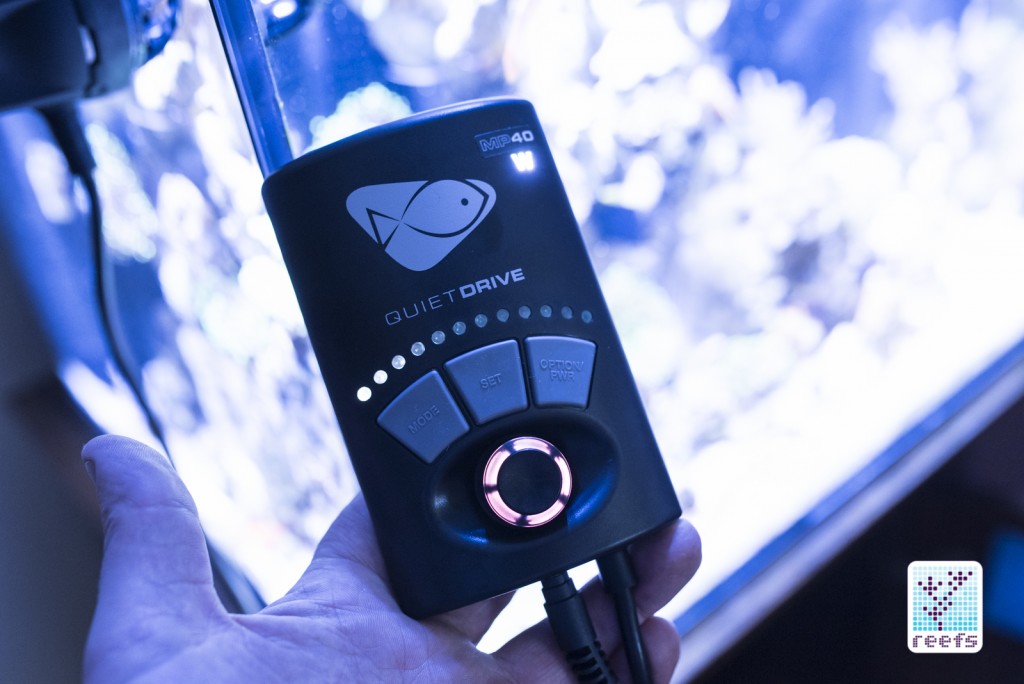
I played with the vortech modes over the course of several hours and found “Reef crest” and “Gyre” modes to be most useable in my cube tank, creating a rather chaotic, non-directional flow pattern. My skimmer produced some micro-bubbles after I cleaned it the day before, and I could clearly see the flow vortech produced. The pump and its modes behave similarly to the previous generation of MP40s, with one significant difference; due to the impeller re-design, the new MP40 QD is much stronger. EcoTech advertises a 40% increase in flow rate (4500 gph maximum flow, compared to MP40 ES’s 3200 gph) and while I don’t own a laboratory with necessary equipment to measure that claim, a simple “hand in front of impeller” test tells that the pump has significantly more output than the previous model. I was especially impressed when I moved the pump to my larger, 48” long freshwater tank and set up the mode to short pulse, maximum speed- vortech created a wave that not only uprooted plants, but also spilled water on over the rim on the opposite side of the aquarium. In my 20” cube reef tank, MP40 QD is an obvious overkill on any but the lowest setting. In my experience, the new vortech is best suited for tanks between 24” to 48” long, a pair of them in a 75-100g tank will be more than enough flow even for an SPS dominated reef setup.
NOISE LEVEL TEST
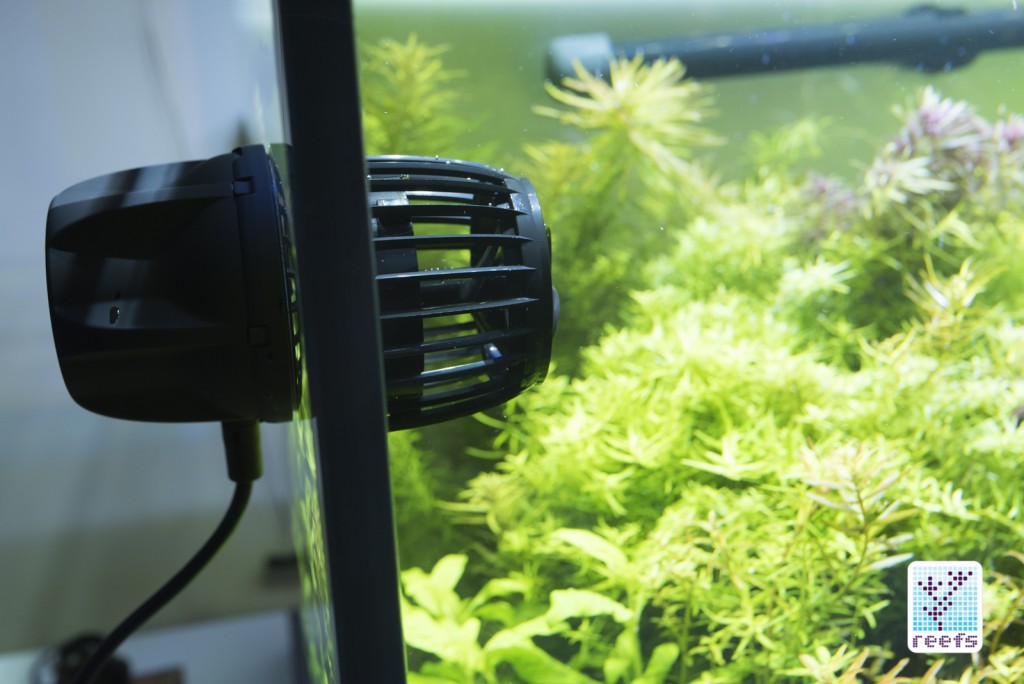
Now, the noise that MP40s create was one of the very few reasons that turn people away from vortech pumps. Ecotech‘s team rushed to correct that problem, reporting back a huge success in noise reduction and advertising it as the biggest selling point in the new QuietDrive line. To test that claim, I turned to a friend of mine, who is a sound systems installer, for help. He recommended to me an affordable model of a sound level meter that give results closest to professional equipment that costs 10 times more. With that tool in hand, I tested the ambient noise level using a weighting method in three steps: before I turned the pump, then at 50% output and finally, with flow dialed all the way up. I repeated this test several times switching between two different modes (constant flow and short pulse) and here are the results:
CONSTANT SPEED MODE
(from left to right: pump off, 50% of speed, full speed)

SHORT PULSE MODE
(from left to right: pump off, 50% of speed, full speed)

The outcome of the noise level test can be framed into one sentence: Ecotech did an outstanding job silencing the new vortech MP40 QD. On short pulse mode, the pump remains virtually silent until around 2/3 of the maximum speed, at which point it becomes more of a hum rather than a motor noise.
CONCLUSIONS
Ecotech did it again- they’ve made an outstanding product even better. Changes might seem subtle at first glance, but the new vortech MP40 QD not only addresses the single biggest problem with its flagship pump- the noise level, but also gives it a tune up in the form of a redesigned propeller that pushes more water than ever before. Sure, we can argue that the price Ecotech charges for the device ($349 for MP40 QD package and $75 for the driver upgrade- prices current as of November 2015) is a little high compared to other similar products, but, in my humble opinion, the price accurately reflects the pump’s value. When buying vortech QuiteDrive propeller pump, you’re getting a beautifully designed and engineered piece of equipment that has no counterparts anywhere on the market, paired with excellent customer service and a high re-sale value.
What about existing vortech owners? It depends on each individual user expectations. If you’re an owner of the original WWD driver, upgrading to the newest QuietDrive is a big step-up, albeit a little pricier than with EcoSmart generation owners (it costs $120 to upgrade from WWD driver to QD). Anyone using ES wireless driver need to ask him/herself a question- do I want my pump to be quiet and do I care about the new Gyre mode? If the answer is yes, then the costs are as follows:
- $95 to upgrade from non-wireless MP10ES to MP10wQD
- $50 to upgrade from MP10wES to MP10wQD
- $75 to upgrade from MP40wES to MP40wQD
- $100 to upgrade from MP60wES to MP60wQD
One thing is for certain- by buying the new Ecotech vortech Quietdrive propeller pump, you’re getting one of the most sophisticated and well-built products in the aquarium industry. I hope my review shined some light on the new Ecotech product. Please share and comment!
All Ecotech pumps come with 1 year warranty. To find out more about the new Vortech QuietDrive, please visit Ecotech official Vortech pumps page and see Ecotech YouTube channel.
All images by the author

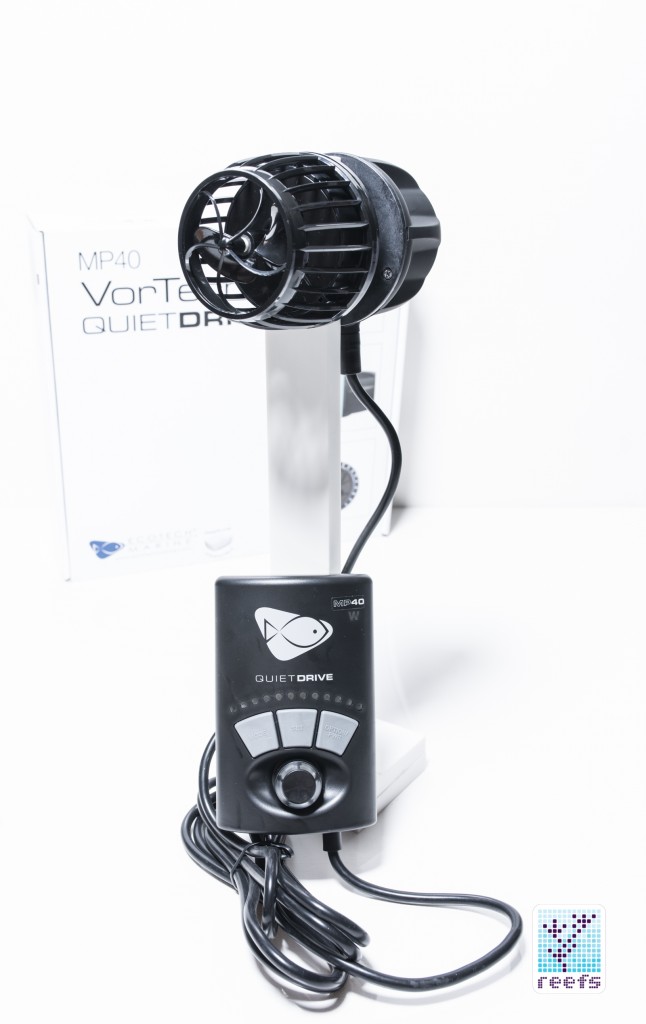
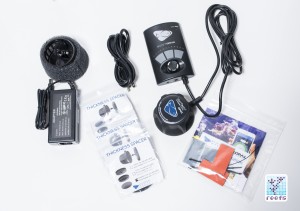
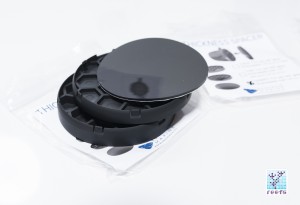
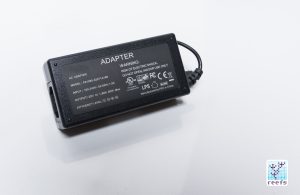


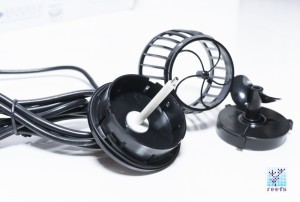










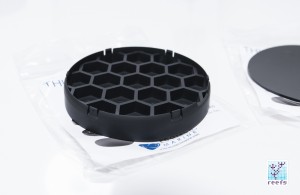


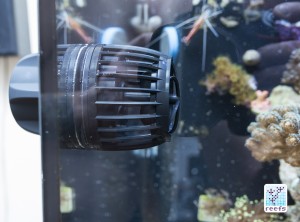



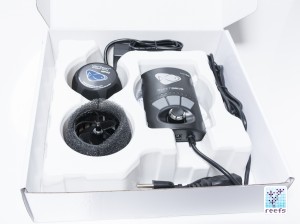

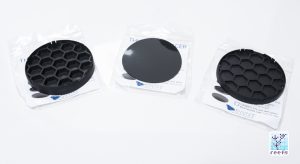

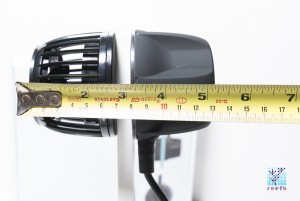
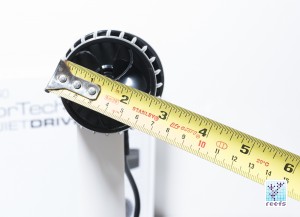

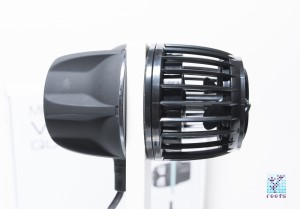

















0 Comments